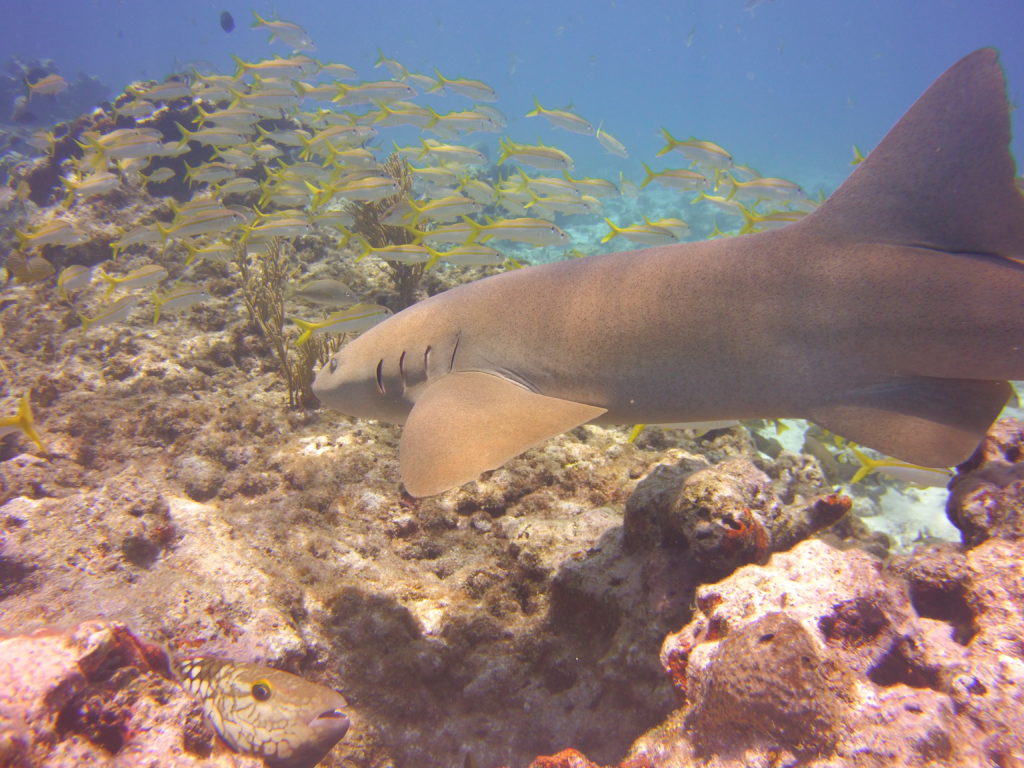Turtles and sharks we see on our excursions to the reef
Encounter the Marvels of the Ocean
Turtles and Sharks grace our Snorkel and SCUBA tours daily, creating delightful moments for all to cherish. On really clear days you can often see harmless nurse sharks sat on the bottom just by looking over the side of the boat whilst Turtles will pop to the surface for air and a quick look around every now and then.
We are often asked if these creatures are dangerous and the answer is alway an outstanding no but you must treat them with respect. If you are with you buddy in the water and you spot a shark by the time you have turned to your buddy and got their attention the shark will have seen you and gone. We should regard ourselves as privileged to encounter them.
Turtles
The 5 types of sea turtles in the Florida Keys are the Loggerhead, Green, Hawksbill, Leatherback and Kemp’s Ridley. This represents 5 of the 7 species of sea turtles, all are on the endangered list.
If you want to know more about how to identify these different turtles the Sea Turtle Conservancy has a nice process to help you do this.
This guy was seen having a snack on French reef late 2017
We spotted this Hawksbill turtle just off Key Largo Dry rocks whilst we were conducting a debris clear-up on Sunday 28
November. Key Largo Dry Rocks is in the John Pennekcamp State Park. This fella was not to far from the Statue of Christ. You can see from the video we surprised him a little during his snacking. We were careful not to get too close to him or disturb him too much. After a few moments he seemed to feel that we were no threat to him and continued with is snack. This is the way we like to video our wildlife, so they do not feel threatened, we could have got closer but the chances are he would have been disturbed too much and swim off.
Green Turtles
Five Fun Facts about Green Turtles
1. Endangered Elegance:
Florida green turtles (Chelonia mydas) are a threatened species, classified as endangered. Despite facing challenges, these majestic creatures continue to thrive along Florida’s coastlines.
2. Herbivorous Habits
Green turtles are primarily herbivores, with a diet consisting mainly of seagrasses and algae. Their feeding habits contribute to the health of seagrass beds and coastal ecosystems.
3. Long-Distance Travelers:
Florida green turtles are known for their incredible navigation skills and long-distance migrations. Some individuals travel thousands of miles between their feeding and nesting grounds, showcasing their remarkable homing abilities.
4. Unique Tear Glands:
These turtles have specialized tear glands that help them excrete excess salt from their bodies, allowing them to survive in both salty ocean water and the brackish waters of estuaries.
5. Nesting Marvels:
Florida green turtles nest on the state’s sandy beaches, with nesting season typically occurring between June and September. Females return to the same beaches where they were born to lay their eggs, exhibiting a fascinating aspect of their life cycle.
Here we see a sleepy little turtle catching some shut eye on one of our dives to the wreck of the Benwood. Courtesy of our friend Tanner for the video
Sharks
We see a number of different types of sharks in Key Largo, mainly Reef Sharks, Nurse sharks and some Bull sharks.
There are however visitors to our shores that are a little larger. Great Whites are known to move up and down the east coast of the US from Maine to Key West. If you want to see progress of these magnificent creatures go to the Ocearch website who track a number of great whites in Florida. This site also tracks turtles!
Heres some footage of a nice reef shark on Molasses reef in July 2017. This guy kind of surprised us more than we surprised him! We had just got into the water and were still under the boat when he came to investigate. Once he realized we were not food he swam off!
Nurse Sharks
We see a lot of Nurse sharks on the reef to the extent where we see them on most trips to the reef. You can often see Nurse Sharks either resting under rocks or patrolling the reefs for food.


Five fun facts about Nurse sharks!
- Nocturnal Beauties:
Nurse sharks (Ginglymostoma cirratum) are primarily nocturnal, preferring to hunt and explore during the night. Their unique behavior makes them more active and visible to divers and snorkelers after the sun sets. - Distinctive Barbel Whiskers:
Nurse sharks possess sensory barbels, similar to catfish whiskers, which protrude from their snouts. These highly sensitive structures help them detect prey hidden in the sand, making them excellent hunters even in low-light conditions. - Bottom-Dwellers with a Lazy Reputation:
Often seen lying motionless on the ocean floor, nurse sharks have earned a reputation for being lazy. However, this behavior is part of their energy-efficient strategy. They can pump water over their gills, allowing them to extract oxygen even when resting. - Slow Swimmers, Fast Feeders:
Nurse sharks are generally slow swimmers, but their feeding strategy is quick and effective. They use suction to consume prey, such as small fish and invertebrates, directly into their mouths. This method allows them to snatch a meal swiftly. - Friendly and Harmless:
Nurse sharks are known for their gentle disposition and are considered non-threatening to humans. They are often encountered by divers and snorkelers, and unless provoked or cornered, nurse sharks are unlikely to pose any danger. Their calm nature makes them a favorite among underwater enthusiasts.
